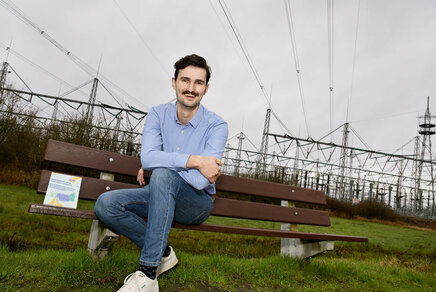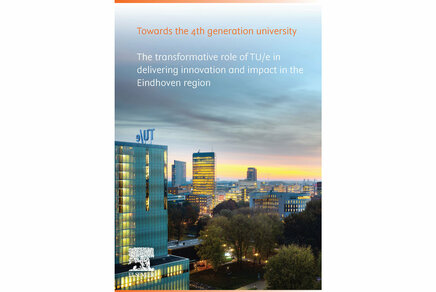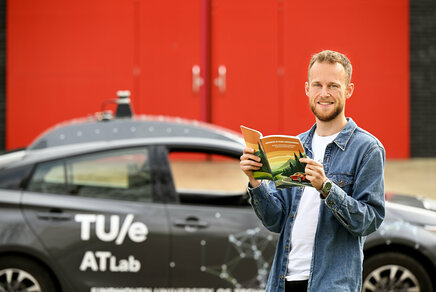Highly sensitive measurement technique leads to better solar cell
For his PhD research, Bas van Gorkom developed a new way to measure defects in perovskite - a material used to make solar cells more efficient.
![[Translate to English:] [Translate to English:]](https://assets.w3.tue.nl/w/fileadmin/_processed_/1/c/csm_Gorkom%20Foto%27s%20promovendus%20Cursor%20-%20001_00c55771f2.jpg)
Solar energy is becoming an increasingly popular source of renewable energy. Current solar panels with silicon as their primary component are affordable and reliable. However, the use of a relatively new material, perovskite, could dramatically improve the solar cell’s efficiency. TU/e researcher Bas van Gorkom developed a highly sensitive technique for measuring defects in the crystal structure of perovskite. This is important, since a better quality of crystal can enhance the stability of perovskite.
In the dark – pitch dark – and away from vibrations and noise. That is how PhD candidate Bas van Gorkom carried out his experiments over the past years. But it wasn’t a dark period, he says jokingly. On the contrary, because once he had set the measurements in motion, he could simply return to daylight.
With the use of a special setup, Van Gorkom developed a highly sensitive measurement technique to obtain information about the crystal structure of perovskite. He will defend his doctoral research at the department of Chemical Engineering and Chemistry on Monday, April the 3rd.
Dynamic bonds
The most widely used technology for current solar cells is crystalline silicon. Some ten years ago, the first perovskite-based solar cells started to emerge. Material and production costs are low, and the manufacturing process of perovskite-based solar cells is relatively energy-efficient and simple. This newest technology, and its so-called tandem cell configuration in particular, has often been described as promising.
A tandem cell consists of a perovskite and silicon solar cell on top of each other, which yields an even higher efficiency. However, perovskite has a number of important drawbacks that continue to limit a large-scale commercial implementation of this technology, Van Gorkom explains. “The bonds between atoms in silicon crystals are very firm, which makes the material very stable. Perovskite crystals contain ions, positive and negative particles, with bonds that are much more dynamic. Exposure to light can cause them to move, which, naturally, creates problems for long term stability. You don’t want a solar cell to become unstable when it absorbs light. Therefore research into the improvement of the stability of perovskite is of great importance.”

That is why Van Gorkom analyzed the perovskite crystal structure in great detail. “You have these beautiful pictures of symmetrical 3D crystal structures with dots and lines that form a mathematical model.
Unfortunately, reality is never perfect. A crystal structure always shows defects. Particles may be missing, or may in the wrong place. In a solar cell, those defects lead to a loss of voltage, which in the end reduces the cell’s efficiency.”
A cable makes the difference
However, measuring defects in the perovskite crystal structure isn’t that simple and at this point, this is mostly done with computer simulations. For some time now, researchers in Van Gorkom’s Molecular Materials and Nanosystems group have been looking for ways to carry out measurements in actual perovskite crystals. They have now managed to do so in mini solar cells, with a highly sensitive photocurrent measurement developed by Van Gorkom and his colleagues.
In a nutshell: they determine, per solar cell and at every wavelength of light, the percentage of light particles emitted from that solar cell as an electron. “Ideally, each light particle absorbed by the solar cell would lead to an electron. By using an indirect method, we can now measure charges in defects, in the form of a tiny amount of current. And we can do so very accurately; we can even see it when 1 in a 100 million light particles is converted into an electron.”
The trick lies in the details, Van Gorkom says. “We spent a lot of time trying to achieve this sensibility. The noise level had to be reduced as much as possible, a cable can make the difference. That is why our set up – which is located in a separate room at an extra stable spot – contains special electronic components. You can’t just copy it, there’s just one similar measuring instrument worldwide. We can now carry out highly specialized measurements, and we’ve received applications from outside the university now as well. Since we are able to show the defects in actual material, we can now specifically try to identify those components that result in a more stable perovskite, up to the lowest possible level.”
Title of PhD thesis: Highly sensitive photocurrent spectroscopy on hybrid perovskite solar cells. Supervisors: René Janssen and Martijn Wienk.
Source: Cursor.
Media contact
More on Sustainability



Latest news

![[Translate to English:] [Translate to English:]](https://assets.w3.tue.nl/w/fileadmin/_processed_/e/6/csm_Hendriks%20Banner%20image%20Photonic%20crystal%20fiber-tip%20sensor%20BvOF_9b4093b84b.jpg)
